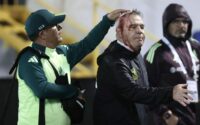Lynn Williams’ underdog story to long-awaited World Cup 2023 with USWNT
Lynn Williams has never taken the easy road.
In March 2022, the striker tore her hamstring completely off the bone during a National Women’s Soccer League game, an ill-timed injury that kept her out for nearly an entire season leading up to the 2023 FIFA Women’s World Cup.
After months of vigorous rehabilitation and training, Williams took to the pitch as a second-half substitute during a U.S. Women’s National Team friendly match against New Zealand in January.
Just minutes after entering the match, on nearly her first touch of the game, Williams scored a goal to punctuate the team’s 4-0 win.
That is her story in miniature. A self-proclaimed underdog who never let setbacks, injuries or naysayers get in the way of achieving her dream: representing the United States at the World Cup.
“It’s the call you always dream of and always want,” Williams, who now plays professionally for NJ/NY Gotham FC, told The Post. “All the hard work I have been doing has paid off, especially after last year when I didn’t even know if I’d be able to come back as the same player.”
The 30-year-old Williams now has taken her place on the USWNT, a group full of young phenoms and well-known legends, in New Zealand and Australia, as the team looks to win its third consecutive World Cup.

A spot on the USWNT seemed secure after Williams helped the U.S. win the bronze medal in 2021 at the Tokyo Olympics, but her 2022 was ruined by the hamstring injury and she was dealt from the Kansas City Current to Gotham FC during the 2023 NWSL Draft in January.
Once she recovered from what she called a “shocking” trade, Williams was grateful Gotham wanted to take a chance on her, especially after she had missed so much time.
“In bringing Lynn here, it automatically sends a message to the team and to everyone else that we’re here to win and win now,” Gotham FC general manager Yael Averbuch West said. “Her consistent success and her professionalism and diligence to come back from her injury, and take her time to really own that process, has all contributed to what we knew she could do. Seeing her doing it is quite inspiring.”

Williams immediately shined with Gotham, becoming a focal point and resuming her place among the top goal scorers in the league (she has seven) to help the team vault to third place in the NWSL standings.
“I felt very secure here at Gotham,” she said. “It’s a great place to learn and continue to develop.”
Williams’ play this spring helped her earn a spot on the 23-player World Cup roster, as a key reserve or even a potential starter.
“[Her performance] in the NWSL certainly had a lot to do with her call-up,” USWNT head coach Vlatko Andonovski said. “We’re going to see a team player, intensity, power, goals and hard work.”
As an energetic child growing up on a pecan farm in Fresno, Calif., Williams’ parents signed her up for both soccer and track.

“I actually thought I would do college track, not soccer, because I wasn’t getting recruited to play for soccer, but I was for track,” Williams said.
But Williams’ love of soccer led her in 2011 to Pepperdine, the only school that recruited her. The American domestic league Women’s Professional Soccer (WPS) had just ceased competition that same year, and the NWSL did not begin play until 2013.
Despite uncertainty around a domestic professional league, Williams was singularly focused on her dream of playing soccer.
“It was national team or bust,” she said. “I couldn’t see myself doing any other job.”
Williams was named the West Coast Conference’s Freshman of the Year, and two years later, received a pair of call-ups to the Under-23 National Team.
“It was an incredible moment to get that call and a whole bunch of nerves to actually get out there with people who [unlike me] grew up in the youth system,” Williams said. “I questioned if I was going to fit in.”
With the NWSL entering its third season, Williams was drafted by the Western New York Flash as the sixth-overall pick in the 2015 college draft.
The transition from college to professional soccer wasn’t easy.
“A coach said I was just an athlete playing soccer, so I started to sit down and study the game a bit more, and a couple years later, he said I was a soccer player who is an athlete,” Williams said. “It was a turning point in my career.”
During her rookie season, the Flash finished in seventh place in the nine-team league.

“I hated it,” she said. “I was away from home, it was cold and we were losing. I questioned if I wanted to do this and if it was worth being away from my family only making $10,000 a year.”
A knee injury took her out of contention for a potential USWNT roster spot for the 2016 Olympics.
Williams began to reflect on and question her path.
“I came to the conclusion that the reason why I love playing is just because I love soccer,” Williams said. “It’s not because of the national team. I want to be on it, of course, but that’s not the reason why I play.”
Williams’ NWSL play led to her first cap with the senior U.S. Women’s National Team in October 2016.
She received consistent call-ups for a couple of years, but missed out on making major tournament rosters and was not selected for the 2019 World Cup.
Despite her absence from the national team, Williams continued to thrive in the NWSL, leading her teams to multiple championships and breaking into the upper echelon of goal scorers in the NWSL (she now has 64 regular-season goals, the second-most in league’s 11-year history).
In late 2019, following a changeover in USWNT coaches, from Jill Ellis to Andonovski, Williams began receiving call-ups again.
“The league made me seen by the national team,” Williams said. “Before, it was either college or the national team, and now there’s this other path to be viewed. I wasn’t with the youth system or U.S. Soccer while growing up besides those two U-23 camps.”
Williams has been a key player during the maturation of women’s soccer in the United States and has benefited directly from it.
The growth of the NWSL has allowed her to thrive, and she is invested in its continued rise.

“It’s cool to be able to be a part of that growth and still benefit from it when it’s growing,” she said. “I feel like a lot of times you work so hard for the next generation, which we are, but I also feel like I get to work hard for my own generation, too.”


